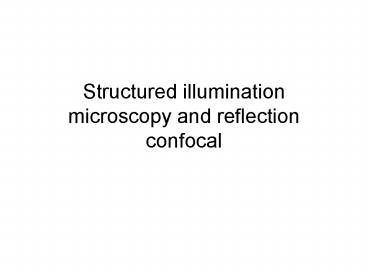Structured illumination microscopy and reflection confocal - PowerPoint PPT Presentation
1 / 19
Title:
Structured illumination microscopy and reflection confocal
Description:
Structured illumination microscopy and reflection confocal Reflection confocal Instead of setting the emission wavelength longer than excitation wavelength, set them ... – PowerPoint PPT presentation
Number of Views:1216
Avg rating:3.0/5.0
Title: Structured illumination microscopy and reflection confocal
1
Structured illumination microscopy and reflection
confocal
2
Structured illumination
- Sample image through a grating 3X, moving the
grating each time by 1/3 pixel - Only in-focus data will have sharp fringes
- Out-of-focus data will be relatively invariant
- I ((I1-I2)2(I1-I3)2(I2-I3)2)1/2 - throws out
all the out-of-focus information - Imperial College Powerpoint
3
Structured illumination illuminators
- Zeiss Apotome
- Whole microscope is approx 100K
- Grabs images 1/second, processes in real time
- Thales Optem Optigrid
- Can be added onto existing scopes
- Relative cheap (20K)
- OptiGrid
4
Mathematical foundations of structured
illumination
- From a mathematical sense, we can say that we are
sampling 3-dimensional image space with a
vertical grid spacing of 1/3 pixel - This should give us a vertical resolution
comparable to X and Y - That is far better than confocal, where Z
resolution is limited to 0.8 µ
5
Extended resolution
- Standing wave fluorescence microscopy
- Principle Perform fluorescence microscopy with a
laser as illumination source - Light reflected from coverslip sets up a standing
wave - Set intensity threshold such that standing wave
only excites fluorophores at its peak
6
Standing Wave Fluorescence
7
Problems
- Works well for very thin specimens
- For, thicker specimens, however, you get
excitation of fluorophores in other parts of the
cell by adjacent standing waves - It is possible to mathematicvally deconvolve, but
a pain!
8
4Pi confocal microscopy
- Instead of using reflection, split laser beam to
have two interfering beams from opposite sides of
the specimen - Significantly, the confocal aperture ensures that
you are only getting fluorescence from one
standing wave
9
Leica TCS 4Pi
10
Actin filaments in fibroblast by 4Pi
Gustafsson, Curr. Opin. Struct. Biol. 9627
11
Resolution of techniques
Gustafsson, Curr. Opin. Struct. Biol. 9627
12
STED
- Depends on phenomenon of Stimulated Emission
Depletion - If we raise a fluorophore to an excited state,
hitting it with the emitted wavelenth can revert
it to the ground state - STED microscopy shines a short ? spot in field
center, and surrounds it with a doughnut of
longer ? STED reduces the size of the spot
13
STED
Stephan Hell
Resolution can be 2X confocal resolution Hells
group has demonstrated 50 nm resolution Leica is
marketing a STED microscope But Microscope is
very elaborate and expensive Pumps a lot of
energy into the specimen photobleaching and
phototoxicity
14
Reflection confocal
- Instead of setting the emission wavelength longer
than excitation wavelength, set them to the same. - Gives image contrast based on reflected (or
really, backscattered) light - Problem hard to interpret
15
Reflection-enhanced backscatter confocal
microscopy
- Cells plated on a specular reflective substrate
look like they were imaged in DIC when viewed by
reflection confocal
16
Mode of image formation in REBCM
In other words, REBCM is an interferometric
technique that measures height above the coverslip
17
Note fringes along filopodia
18
REBCM can show individual microtubules
19
REBCM offers increased resolution
100 nm fluorescent beads are resolved in REBCM,
but not in fluorescence































